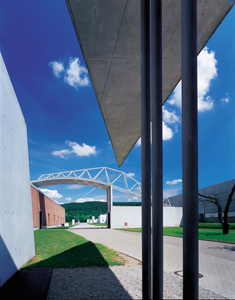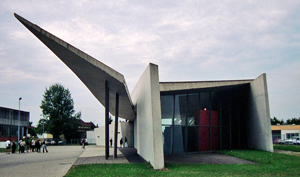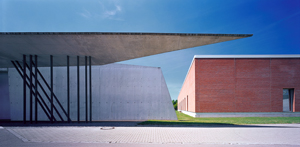 |
 |
 |
 |
 |
 |
| |
 |
|
 |
 |
 |
  |
  |
 |
 |
 |
 |
|
|
 |
|
 |
 |
 |
BUILDING |
 |
|
 |
|
 |
 |
 |
| |
 |
| 
 |
Fire Station
|
|
 |
 |
 |
 |
DESIGNER |
 |
|
|
 |
|
 |
 |
 |
| |
 |
|
 |
 |
 |
 |
DESCRIPTION |
 |
|
|
 |
|
 |
 |
 |
| General Design Strategies and Architectural Concepts |
 |
|
 |
 The project began as a commission to build a fire station in the north-east section of the vast Vitra factory complex in Weil am Rhein. The brief was soon extended to cover the design of the boundary walls, a bicycle shed and an exercise structure for the fire brigade. The project began as a commission to build a fire station in the north-east section of the vast Vitra factory complex in Weil am Rhein. The brief was soon extended to cover the design of the boundary walls, a bicycle shed and an exercise structure for the fire brigade.
We initiated our design with a study of the overall factory site. Our intention was to place the elements of our commission in such a way that they would not be lost between the enormous factory sheds. We also used these elements to structure the whole site, giving identity and rhythm to the main street running through the complex. This street, which stretches from the Vitra Design Museum to the other end of the factory site where the fire station is now located, was envisaged as a linear landscaped zone, almost as if it were the artificial extension of the linear patterns of the adjacent agricultural fields and vineyards.
This had specific implications for the fire station. Rather than designing the building as an isolated object, it was developed as the outer edge of the landscaped zone, defining space rather than occupying space. This was achieved by stretching the programme into a long narrow building alongside the street.
The building is located at the end of the main axis where it cuts at an angle into the main street and, is bent within itself, leading the street around to the back end of the company ground. While marking the edge of the factory site, the fire station also functions as a screening device against the bordering buildings.
The space-defining and screening functions of the building were the point of departure for the development of the architectural concept, a linear, layered series of walls. The programme of the fire station inhabits the spaces between these walls, which puncture, tilt and break according to the functional requirements.
The main puncture is constituted by the movement of the fire engines, which cut across the linear flow of the walls and surrounding landscape. Sliding open the doors in one of the walls reveals the fire trucks beyond, parked under a large roof. Captured between further walls, two linear spaces intersect, each relating to different parts of the programme. A third space above is engendered by the continuation of the wall beam spanning the garage space. The building is hermetic from a frontal reading, revealing the interiors only from a perpendicular viewpoint.
As one passes across the spaces of the fire station, one catches glimpses of the large red fire engines. Their lines of movement are inscribed into the asphalt. The whole building is movement, frozen. It expresses the tension of being on the alert and the potential to explode into action at any moment. The walls appear to slide past each other, while the large sliding doors literally form a moving wall. |
|
 |
 |
 |
|
 |
|
| Functional layout |
 |
|
 |
 The design unifies two very different parts of the programme: the housing of fire trucks and the provision of various facilities for fire- fighters. The concept of the stacked walls encompasses both parts, whereby the intersection of the two is expressed by a break or bend in the line of the building. The entrance to the building is precisely at this junction. The design unifies two very different parts of the programme: the housing of fire trucks and the provision of various facilities for fire- fighters. The concept of the stacked walls encompasses both parts, whereby the intersection of the two is expressed by a break or bend in the line of the building. The entrance to the building is precisely at this junction.
This point of entry is also the control point from which the building is operated. From here one enters the garage via the equipment space, which is separated from the garage proper by means of a free standing plane only. The garage itself is laid out for five engines. Five parallel lanes run at a 60 o angle through the wall into the garage. Two of these lanes emerge from the rear entry, allowing for outdoor maintenance. The garage presents itself in elevation as a long wall of sliding doors with an canopy floating above.
The spaces for the fire-fighters are organised into three long volumes, or "beams", represented in elevation by three distinctively expressed walls. One beam is made up of a series of compartments containing the changing areas for 25 male and 10 female fire-fighters. This beam includes various sanitary installations as well as a first aid room and technical room. Its exterior wall is solid and tilts outwards, with a series of narrow slits as the only openings. The cellular, compact volume of the beam is cut open by a long, uninterrupted space with a high and rising ceiling and continuous glazing, gently curved.
This is the fitness space and the second beam, expressed externally by the rising, curved glass wall, three long, space-dividing steel cupboards - the lockers - mediate between the two intersecting beams. In the zone of intersection the ceiling is cut open. Here, a cantilevered stair rises to a third beam, the so called club room, which functions as seminar space as well. This space leads to the terrace over the fitness space. In the other direction, it overlooks the garage roof. The exterior wall of this third beam is a continuation of the structural member which spans the garage. It is distinguished by a very long, relatively low, opening with louvres set into it, almost as if the wall were sliced horizontally. |
|
 |
 |
 |
|
 |
|
| Lighting Scheme |
 |
|
 |
| All lighting is integrated into the architecture and is based on the concept of lines, rather than points. These lines are set into the planes as cuts from which light emanates, rather than as bodies which obtrude into the space. The lines of light direct the necessarily precise and fast movement through the building. For example, the garage is lit from cuts in the floor. These define lanes of movement for the fire engines. |
|
 |
 |
 |
 |
 |
 |
 |
VIDEO |
 |
|
|
 |
|
 |
 |
 |
| |
 |
|
 |
 |
 |
 |
MATERIALS |
 |
|
|
 |
|
 |
 |
 |
 |
 |
|
reinforced concrete  The whole building is constructed of exposed, reinforced in-situ concrete. This proved to be the most suitable medium with which to realise our intentions: sculptural expressiveness and structurally ambitious long spans and cantilevers. Special attention was given to the sharpness of all edges, any attachments like roof edgings or claddings were avoided, as they distract from the simplicity of the prismatic form and the abstract quality of the architectural concept. This same "absence" of detail informed the frameless glazing, the large sliding planes enclosing the garage and the treatment of the interior spaces - including the lighting scheme described below. The whole building is constructed of exposed, reinforced in-situ concrete. This proved to be the most suitable medium with which to realise our intentions: sculptural expressiveness and structurally ambitious long spans and cantilevers. Special attention was given to the sharpness of all edges, any attachments like roof edgings or claddings were avoided, as they distract from the simplicity of the prismatic form and the abstract quality of the architectural concept. This same "absence" of detail informed the frameless glazing, the large sliding planes enclosing the garage and the treatment of the interior spaces - including the lighting scheme described below.
A number of structural achievements contribute to the intended dynamics of the design. The main span over the five lanes of the garage, including the entrance area, measures 32 metres in length. The canopy hovering above the garage opening cantilevers 4 metres from the main beam, until it splits off, resting on a series of slender columns. From here it cantilevers another 12 metres along its axis. The short end of the garage space is enclosed by a 90 square metre tilted glass wall. The curved, frameless glass wall of the fitness space occupies an opening with an uninterrupted span of over 29 metres. The opening in the club room measures 21 metres and returns around the corner, leaving the heavy top end of this 70 metre long wall to cantilever. The stair leading to the club room is made from pre-cast concrete slabs, which cantilever individually from the wall.
The five sliding doors closing the garage are hung from the main beam as 23 square metre leaves, finished in brushed aluminium. The two pivot doors in the back measure 30 square metres each.
The interiors of those spaces that require insulation are rendered. The sanitary wall is tiled in glass mosaic. The lockers which mediate between the changing and fitness areas are made from steel and stainless steel respectively. A gilded wall tilts outwards at the end of the fitness room.
|
|
 |
 |
 |
 |
LOCATION |
 |
|
|
 |
|
 |
 |
 |

|
 |

|
Continent |
|
 |
|
Nation |
|
 |
|
Land |
|
 |
|
District |
|
 |
|
Town |
|
 |
|
Neighborhoods |
|
 |
|
Address |
|
 |
|
|
|
 |
|
 |
 |
 |
 |
MAP |
 |
|
|
 |
|
 |
 |
 |
| |
 |
|
 |
 |
 |
 |
|
TYPOLOGY |
 |
|
|
 |
|
 |
 |
 |
|
|
 |
ARCHITECTURE | Buildings for cultural activities
Art galleries and exhibition areas
Industrial buildings and plants
Service buildings
| |
 |
 |
 |
 |
CHRONOLOGY |
 |
|
|
 |
|
 |
 |
 |
Project |
 |
|
 |
| 
 |
1988
|
|
Realisation |
 |
|
 |
| 
 |
1991 - 1993 |
|
 |
 |
 |
 |
THE BUILDING IN CINEMA |
 |
|
|
 |
|
 |
 |
 |
| Title |
 |
|
 |
| Zaha. An Architectural Legacy |
|
| Directed by |
 |
|
 |
| Jim Stephenson, Laura Mark |
|
| Nationality |
 |
|
 |
|
| Year of production |
 |
|
 |
|
| Cast |
 |
|
 |
| Zaha Hadid, Laura Mark, Eva Jiřičná, Nigel Coates, Christine Murray, Patrik Schumacher, Giovanna Melandri, Ricky Burdett, Hanif Kara |
|
| Building's role |
 |
|
 |
|
 |
 |
 |
 |
 |
 |
 |
BIBILIOGRAPHIC REFERENCES |
 |
|
|
 |
|
 |
 |
 |
|
 |
| Elena Formia, "17 errori griffati/1. Raddrizza che ho la nausea", Il giornale dell'architettura 65, settembre 2008, "Inchiesta/Quando le archistar sbagliano" p. 5 (5-6, 8-9) |
|
|
| "Estació de Bomberos de Vitra/Vitra Fire Station", Zaha Hadid. 1983 2004, El Croquis [52+73+103], Madrid 2004, pp. 140-161 |
|
|
| Paul Warchol (photo), "Cultura U.S.A./American culture", Domus 816, giugno/june 1999 [Cultura U.S.A./American culture], p. 162 |
|
|
| Luigi Prestinenza Puglisi, Hyperarchitettura. Spazi nell'età dell'elettronica, Testo&Immagine, Torino 1998, p. 26 |
|
|
| Marco De Michelis (ed.), Atlante. Tendenze dell'architettura europea. Gli anni Novanta, Marsilio, Venezia 1996, pp. 66-73 |
|
|
| Cesare De Sessa, Zaha Hadid. Eleganze dissonanti, Universale di Architettura, Testo&Immagine, Torino 1996, pp. 47 -57 |
|
|
"Vitra. Ando, Gehry, Hadid, Siza", Lotus international 85, maggio/may 1995 [Dopo il Guggenheim/After the Guggenheim], "Vitra" pp. 74-99
Matthias Ackermann, "Figure di artisti alle porte della fabbrica/Figures of Artists at the Gates of the Factory", Lotus international 85, maggio/may 1995 [Dopo il Guggenheim/After the Guggenheim], "Vitra" pp. 74-99
"Stazione dei pompieri/Fire Service Building. Zaha Hadid", Lotus international 85, maggio/may 1995 [Dopo il Guggenheim/After the Guggenheim], "Vitra" pp. 94-95 (74-99) |
|
|
| L'Industria delle Costruzioni 273-274, luglio-agosto/july-august 1994, pp. 40-47 |
|
|
| a+u. Architecture and Urbanism 277, october 1993, pp. 4-63 |
|
|
| Michael Mönninger, "Zaha M. Hadid. Fire Station, Weil am Rhein", Domus 752, settembre/september 1993, pp. 54-61 |
|
|
| Marie-Jeanne Dumont, "Zaha Hadid, Poste de Pompiers pour Vitra", L'architecture d'aujourd'hui 288, septembre/september 1993 [Mexique], "Ouverture" pp. 4-11 |
|
|
| "Vitra. Estació de protecció contra incendios/Fire Station. Weil am Rhein, Alemania, 1990/1991", El Croquis 52, diciembre 1991-enero 1992/december 1991-january 1992 [Zaha Hadid 1983/1991], pp. 110-125 |
|
 |
 |
 |
 |
 |
 |
 |
CLIENT |
 |
|
|
 |
|
 |
 |
 |
| |
 |
|
 |
 |
 |
 |
DIMENSIONAL
DATA |
 |
|
|
 |
|
 |
 |
 |
| Surface |
 |
|
 |
ground floor sq.m. 350
garage (ground floor) sq.m. 370
upper floor sq.m. 86 |
|
 |
 |
 |
 |
STRUCTURES |
 |
|
|
 |
|
 |
 |
 |
| |
 |
| Gerhard Schmidt, Weil am Rhein |
|
 |
 |
 |
 |
STAFF |
 |
|
|
 |
|
 |
 |
 |
|
 |
|
Project architect |
 |
|
Design team |
 |
Zaha Hadid with Patrick Schumacher
Kar Hwa Ho, Voon Yee Wong, Simion Koumjian, Edgar Gonzales, Craig Kiner, Cristina Verissimo, Maria Rossi, D. Chadwick, C. Kiner, David Gomersall, D. Hunter Gorman, Nicola Cousins, Olaf Weishaupt |
|
Associate architect |
 |
GPF & Associates
Günter Pfeiffer and Roland Mayer, Lörrach |
|
Consulenti per le strutture |
 |
| Sigma Karlsruhe Gmbh, Ove Arup & Partners, London, John Thornton |
|
Systems |
 |
| Ingenieurbüro für Haustechnick, Eduard Behringer, Todnau; Planungsbüro für Elektrotechnik VED, Klaus Schepperle, Lörrach |
|
Design detail |
 |
| Zaha M. Hadid with Signy Svalastoga and Patrik Schumacher |
|
Plastic models, rendering, visualization |
 |
| Daniel Chadwick, Tim Price Associates Two |
|
 |
 |
 |
 |
ANNOTATIONS |
 |
|
|
 |
|
 |
 |
 |
| |
 |
|
 |
 |
 |
 |
RELATED PROJECTS |
 |
|
|
 |
|
 |
 |
 |
| |
 |
|
 |
  |
 |
|
|